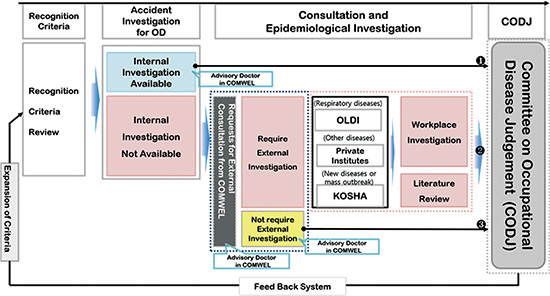3. Korea Workers' Compensation and Welfare Service. Analyses of occupational diseases deliberated by the Committee on Occupational Diseases Judgment in 2010. Seoul: Korea Workers' Compensation and Welfare Service;2011.
16. Provision of the Operation of the Committee on Occupational Disease Judgment of the Republic of Korea: Provision of the Korea Workers' Compensation and Welfare Service No. 717, (25 June 2012), Article 5, Seoul, 2012. accessed on 27 December2013. Available at
http://www.law.go.kr/LSW/admRulInfoPWah.do?admRulSeq=2000000077866.
17. Provision of the Operation of the Committee on Occupational Disease Judgment of the Republic of Korea, Provision of the Korea Workers' Compensation and Welfare Service No. 717 (25 June 2012), Article 1, Seoul, 2012. accessed on 27 December 2013. Available at
http://www.law.go.kr/LSW/admRulInfoPWah.do?admRulSeq=2000000077866.
29. Korea Workers' Compensation and Welfare Service. Analysis of the personnel responsible for compensations in the Korea Workers' Compensation and Welfare Service (Internal data). Seoul: Korea Workers' Compensation and Welfare Service;2013.
30. Provision of the Operation of the Committee on Occupational Disease Judgment of the Republic of Korea, Provision of the Korea Workers' Compensation and Welfare Service No. 717 (25 June 2012), Article 9, Seoul, 2012. accessed on 27 December 2013. Available at
http://www.law.go.kr/LSW/admRulInfoPWah.do?admRulSeq=2000000077866.
31. Provision of the Operation of the Committee on Occupational Disease Judgment of the Republic of Korea. Provision of the Korea Workers' Compensation and Welfare Service No. 717 (25 June 2012), Article 4, Seoul, 2012. accessed on 27 December 2013. Available at:
http://www.law.go.kr/LSW/admRulInfoPWah.do?admRulSeq=2000000077866.
32. Provision of the Operation of the Committee on Occupational Disease Judgment of the Republic of Korea. Provision of the Korea Workers' Compensation and Welfare Service No. 717 (25 June 2012), Article 11 and Clause 2, 2012. accessed on 27 December 2013. Available at
http://www.law.go.kr/LSW/admRulInfoPWah.do?admRulSeq=2000000077866.







 PDF
PDF ePub
ePub Citation
Citation Print
Print





 XML Download
XML Download